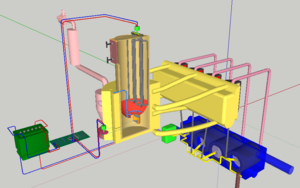
What is an Electric Generator?[edit | edit source]
A electricity generator, electrical generator, engine-generator, generator-set or gen-set is a device that converts mechanical energy into electrical energy (electricity), generally using electromagnetic induction (by means of a alternator or dynamo).
The source of the mechanical energy used to generate the electricity may be a heat, pneumatic or electric motor, a wind turbine, human or animal labour, the sun, or the ocean.
The reverse conversion of electrical energy into mechanical energy is done by a motor. A heat engine and alternator/dynamo assembly that is also used to provide heat (for space heating) is called a "combined heat and power system".
How Electric Generators Work[edit | edit source]
Electric generators operate based on the principle of electromagnetic induction, discovered by Michael Faraday. When a conductor moves through a magnetic field, it generates a flow of electric current. This mechanical energy, typically supplied by a turbine, engine, or other power sources, is converted into electrical energy used to power devices and systems.
Types of Electric Generators[edit | edit source]
There are various types of electric generators, each designed for specific uses and energy sources:
- Portable Generators: Small, versatile units ideal for powering tools or small appliances in locations without access to grid electricity.
- Standby Generators: Often used as backup power in homes and businesses, these generators automatically turn on during power outages.
- Inverter Generators: Known for their efficiency and ability to provide clean, stable energy, often used for sensitive electronics.
- Renewable Energy Generators: These use sustainable sources like solar, wind, or hydroelectric power to produce electricity.
Generator Efficiency[edit | edit source]
The efficiency of an electric generator depends on its design and the energy source used. Renewable energy generators, such as wind turbines or solar panels, are becoming more efficient with technological advancements, offering a sustainable solution to meet global energy demands. However, traditional generators powered by diesel or gasoline may suffer from energy losses due to fuel combustion.
The Role of Electric Generators in Renewable Energy[edit | edit source]
Electric generators are key players in renewable energy systems. They are integrated with solar panels, wind turbines, and hydropower systems to convert natural energy into usable electricity. By improving the efficiency and scalability of these generators, the renewable energy sector continues to grow as a viable alternative to fossil fuels.
Applications of Electric Generators[edit | edit source]
Electric generators have a broad range of applications:
- Residential: Power backup during outages.
- Commercial: Power supply for industries, construction sites, and events.
- Renewable Energy Systems: Integration into solar, wind, and hydropower systems for sustainable energy.
See also[edit | edit source]
- Improving system efficiency by combining engines
- Appropriate technology#Energy
- Rural Electrification Systems
- Compressed air energy storage and use system
- Human powered electricity generator
- BioLite Home Stove and BioLite Camp Stove